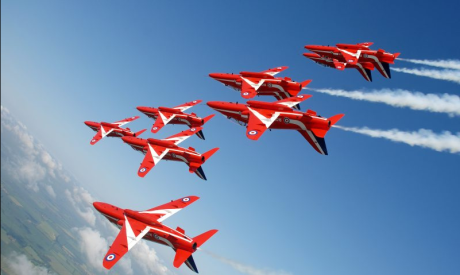
The RAF Typhoon aircraft were scrambled to intercept a civilian aircraft that lost comms with the Air Traffic Control agencies in UK airspace.
A loud sonic boom was heard across Cambridgeshire in eastern England earlier today as two RAF Typhoon jets accelerated to supersonic speed to respond to a ComLoss: a civilian aircraft not responding to the radio calls of the ATC agencies. The two British jets were scrambled from RAF Coningsby, to intercept a Bombardier Global Express registration D-AFAL operating as IFA6016 from Flughafen Nuernberg Airport, Germany, that experienced the temporary radio failure over southeastern UK.
At around 13.00GMT, the lead aircraft, flying as 5KM41, was cleared to accelerate to supersonic speed up to Mach 1.6:
1301z: Permission for Mach 1.6, sonic boom heard over Cambridgeshire
— Mil Radar (@MIL_Radar) January 12, 2021
The subsequent sonic boom was heard (and caught on camera) from Cambridge to London.
Caught the sonic boom on my ring camera!#sonicboom pic.twitter.com/Z8IoF5A7ki
— Javelin Sam (@javelinsam) January 12, 2021
According to the detailed report published on the EGXW Info Group QRA Log, the Typhoons were able to establish radio contact with the “zombie” (as the target aircraft is called in QRA lingo) on 121.5 MHz frequency and broadcast the standard call: “?6016 from 5KM42 I am instructed by Her Majesty’s Government of the United Kingdom to warn you that if you do not respond immediately to my orders you will be shot down” and was issued a turn order.
— Tnetennba 😷 (@Tw4ter) January 12, 2021
The pilot replied that he was complying with ATC instructions at that time and was ordered to continue to follow ATC Direction while it was shadowed by the two Typhoons into Stanstead, that is the most common destination in previous similar incidents.
The aircraft landed and was escorted by airfield operations to an isolated area at Stanstead.
Sonic booms often send media (and people) into a frenzy.
On Sept. 30, 2020, an almost routine intercept by a French Air Force Rafale from BA 113 Saint-Dizier made the news after the loud sonic boom of the jet flying at supersonic speed was heard all over Paris and neighbouring suburbs. The French fighter was responding to a COMLOSS event: a civilian Embraer ERJ 145, flying from Brive to Saint-Brieuc, that had lost radio contact with the ATC. The French jet went supersonic at 11.42LT, when it was flying at about 33,000 feet over the eastern part of Paris. The atmospheric conditions caused the sonic boom to be quite strong, rattling Parisians already on edge after a knife attack outside the former offices of satirical weekly Charlie Hebdo, that the government had called an act of terror.
The loud bang also forced the players at the French Open tennis tournament to halt for a while judging the sound which resembled an explosion.
Here’s what I always write about sonic booms during QRA launches:
Dealing with sonic booms generated by interceptors on QRA they are nothing special: fighters need to intercept the civilian aircraft experiencing a loss of communication in the shortest time possible and to reach their “target” they can be cleared to perform a supersonic intercept “breaking” the sound barrier in the process. Supersonic intercepts are routine, when needed, all around the world. However, depending on the time of the day, period, region, etc, they can send the local media into a frenzy, especially after emergency agencies telephone switch boards start receiving reports of a large bang or “explosion”. However, as I commented in a past article about an Italian Air Force supersonic scramble:
Nothing special then, just “the sound of freedom”…
And here’s a more technical explanation of what a sonic boom is:
Although it is often referred to as the “breaking of the sound barrier”, the “sonic boom” is a continuous effect that occurs while the aircraft is travelling at supersonic speeds and not only when it accelerates through Mach 1.
When an aircraft flies, it creates a series of pressure waves in front of the aircraft and behind it. These waves travel at the speed of sound and, as the speed of the object increases, the waves are compressed and eventually merge into a single shock wave. The shock, due to the quick “jump” from a low pressure / low temperature / supersonic airflow zone to a high pressure / high temperature / subsonic speed zone, is perceived by the human brain as a loud “bang”. Depending on several factors, the observer can hear a double “bang”: one when the initial pressure-rise reaches an observer, and another when the pressure returns to normal.



